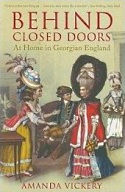-
History of:
- Resources about:
- More:
- Baby walkers
- Bakehouses
- Bed warmers
- Beer, ale mullers
- Besoms, broom-making
- Box, cabinet, and press beds
- Butter crocks, coolers
- Candle snuffers, tallow
- Clothes horses, airers
- Cooking on a peat fire
- Drying grounds
- Enamel cookware
- Fireplaces
- Irons for frills & ruffles
- Knitting sheaths, belts
- Laundry starch
- Log cabin beds
- Lye and chamber-lye
- Mangles
- Marseilles quilts
- Medieval beds
- Rag rugs
- Rushlights, dips & nips
- Straw mattresses
- Sugar cutters - nips & tongs
- Tablecloths
- Tinderboxes
- Washing bats and beetles
- Washing dollies
- List of all articles
Subscribe to RSS feed or get email updates.
Behind Closed Doors: At Home in Georgian England by Amanda Vickery
from Amazon.comor Amazon UK
Until "lucifers" [matches invented in the 1830s] became cheap and in general use, the matches sold by the street-folks...were usually prepared by themselves...Wooden splints, twice or thrice the length of the lucifer matches now in use, were prepared, and dipped into brimstone, melted in an iron ladle. The matches were never...self-igniting, or...ignitable by rapid friction; but it was necessary to "strike a light" by the concussion of a flint and steel, the sparks from which were communicated to tinder kept in a "box".
The brimstone match-sellers were of all ages, but principally...old people. Many of them...wore tattered regimentals, or some remains of military paraphernalia, and had been...soldiers, but not entitled to a pension; the same with seamen. [Some] of the match-sellers.....displaced their "brimstones" for "lucifers", and traded on as usual.
Henry Mayhew, London Labour and the London Poor, 1851
Sulphur matches
Brimstone matches for the tinderbox
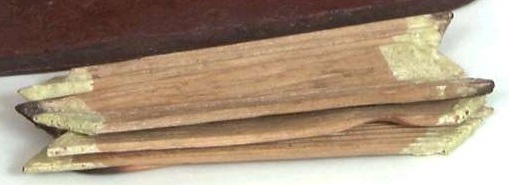 >>>> Tinderboxes - click for main tinderbox page
>>>> Tinderboxes - click for main tinderbox page
Brimstone matches were thin pieces of wood dipped at each end in sulphur, also called brimstone. For anyone using a tinderbox to strike a light they were a great help, even though they seem very inferior to us now in the age of friction and safety matches.
After you caught a spark on a piece of tinder, touching it with a sulphur match gave you a small flame, and you could light your candle quite easily.
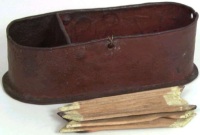 Of course there could be problems: damp matches were often mentioned as one of them.*
Perhaps they got damp because they didn't fit into the round, tin tinderboxes
so popular in some places. A longer kind of box suited them better.
Of course there could be problems: damp matches were often mentioned as one of them.*
Perhaps they got damp because they didn't fit into the round, tin tinderboxes
so popular in some places. A longer kind of box suited them better.
...the infant at its mother's side too often awoke.....The mother was soon on her feet; the friendly tinder-box was duly sought. Click, click, click; not a spark tells upon the sullen blackness. More rapidly does the flint ply the sympathetic steel. The room is bright with the radiant shower. But the child....shouts till the mother is frantic. At length one lucky spark does its office - the tinder is alight. Now for the match. It will not burn.....Another match, and another, and another. They are all damp. The baby is inexorable; and the misery is only ended when the goodman has gone to the street door, and after long shivering has obtained a light from the watchman.
Charles Knight, Once Upon a Time, 1854
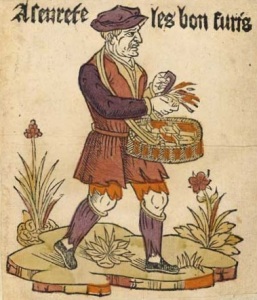 Match
originally meant the wick of a candle, and the word was also used for scraps of
cord, cloth, splinters and so on dipped in sulphur: anything that would hold a flame
for a moment or two. This makes it difficult to be sure who used what with their
steel, flint, and tinder.
Match
originally meant the wick of a candle, and the word was also used for scraps of
cord, cloth, splinters and so on dipped in sulphur: anything that would hold a flame
for a moment or two. This makes it difficult to be sure who used what with their
steel, flint, and tinder.
Brimstone matches a few inches long were cheap and easily available in towns until tinderboxes died out in the mid-19th century. How many people in rural areas had a stock from town or made them themselves? Certainly the art of kindling fire without bought matches was not lost, and some people managed without sulphur.
Matches and match sellers
The matches were thin splints of soft wood, sharpened at both ends, and tipped with sulphur. The street-dealers were the chief match-sellers. Several matches were spread out, fan-like, into bunches; and according as trade was bad or good, so were we invited to buy three, four, or more bunches for a penny.
Matches and Match-makers, in Chamber's Journal, 1862
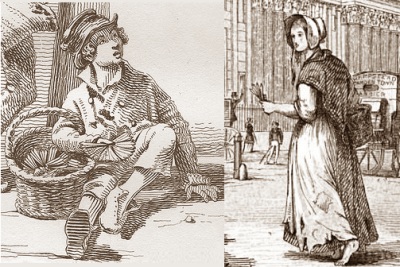 Making and selling matches was for very poor people. In the 19th century it was
seen as an occupation for the disabled or the young, and others at
the bottom of the heap. Match-selling overlapped with begging. The harshest commentators
in Victorian London thought carrying a few splinters of wood with you was not a
serious effort to earn pennies, just an attempt to avoid arrest for being a vagabond
or beggar. In the social unrest of 1830s England, a more sympathetic writer
described watchmen:
Making and selling matches was for very poor people. In the 19th century it was
seen as an occupation for the disabled or the young, and others at
the bottom of the heap. Match-selling overlapped with begging. The harshest commentators
in Victorian London thought carrying a few splinters of wood with you was not a
serious effort to earn pennies, just an attempt to avoid arrest for being a vagabond
or beggar. In the social unrest of 1830s England, a more sympathetic writer
described watchmen:
...who every hour, to prove their vigilance, sent in some poor wretch, beggar or match-seller, or rambling child, under the denomination of suspicious persons...
Mary Mitford, Our Village, 1832
Many of the old brimstone match sellers made thier own stock. Some moved on to selling modern "lucifer" matches, but as these were made in factories, the trade changed.
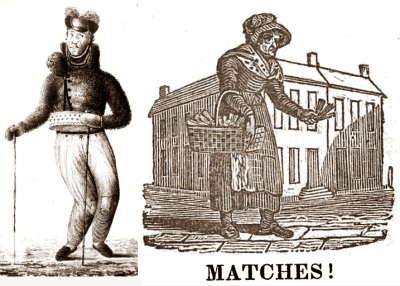 Match sellers in the pictures
Match sellers in the pictures
Top to bottom, left to right: Late medieval French street seller, pictured with a steel, sells his matches in boxes, a novelty in 15th century Paris. Others are all early 1800s. A boy in Bristol, England, and a young woman in London with a ragged skirt. Portrait of a real-life match seller in Trondheim, Norway, with a tray hung round his neck. Woman with basket in New York.
- Other pages on fire or light:
- Tinderboxes for home use
- Tallow candles and snuffers
- Rushlights
- Peat and turf fires
- Fireplaces
- Cooking outdoors with lime and no fire
 4 May 2012
4 May 2012
* re Damp sulphur matches - Have you read Jack London's To Build A Fire?
You may like our new sister site Home Things Past where you'll find articles about antiques, vintage kitchen stuff, crafts, and other things to do with home life in the past. There's space for comments and discussion too. Please do take a look and add your thoughts. (Comments don't appear instantly.)
For sources please refer to the books page, and/or the excerpts quoted on the pages of this website, and note that many links lead to museum sites. Feel free to ask if you're looking for a specific reference - feedback is always welcome anyway. Unfortunately, it's not possible to help you with queries about prices or valuation.


